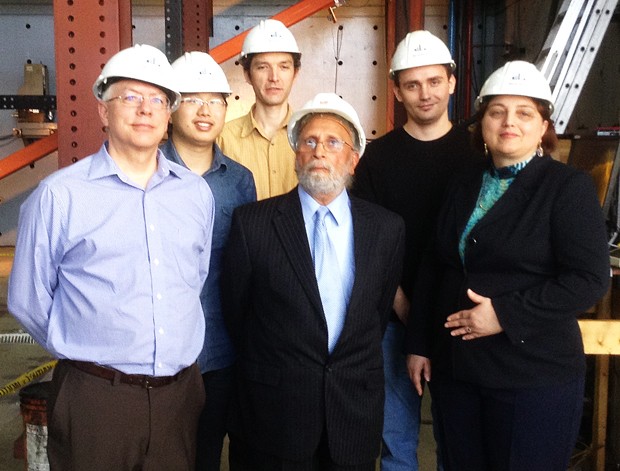Nouvelles
Concordia and Polytechnique Montréal join forces to simulate an earthquake
Full-scale, real-time testing of the Pall Friction Damper seismic control system is producing useful data for Canada's building code
In a large space at the Polytechnique Montréal, a very noisy process is underway. Hoses writhe while actuators slide and
thump, all of them systematically applying stress to a large metal brace.
It's a startlingly effective simulation of an earthquake, and it's taking place because Concordia University and Polytechnique
Montréal are collaborating on a full-scale, real-time test of the Pall Friction Damper seismic control system, which is
designed to mitigate the natural disaster's impact on buildings.
In Polytechnique Montréal's structural engineering laboratory, a team led by Lucia Tirca, an assistant professor in Concordia's
Department of Building, Civil and Environmental Engineering, and Robert Tremblay, a professor in Polytechnique's Department of
Civil, Geological and Mining Engineering, is testing and analyzing the response of a steel brace protected by a Pall Friction
Damper to the force equivalent of the one g of acceleration.

Concordia-Polytechnique Montréal team: Robert Tremblay, professor in Polytechnique's Department of Civil, Geological
and Mining Engineering; Concordia research assistant Yan Jiang; Polytechnique laboratory manager Xavier Willem; Avtar Pall,
president of Pall Dynamics; Concordia MASc candidate Ovidiu Serban; and Lucia Tirca, assistant professor, Building, Civil &
Environmental Engineering.
The idea is to reproduce the behaviour of a real building during an earthquake — specifically the lateral displacement of
the structure's elements that occurs when one hits. The question, then, is whether the Pall Friction Damper can protect the
theoretical structure and, in turn, the real thing.
“The conventional building code philosophy is to design structures to resist moderate earthquakes without significant
damage and to avoid collapse during a major earthquake,” says Avtar Pall, the inventor of the Pall system.
“In general, survival of people is achieved at the cost of damage to the building, by the ductility of the structure,
which dissipates seismic energy while undergoing large, inelastic deformations causing bending, twisting and
cracking.”
The end result is usually an expensive repair process. As Pall explains, though, the use of friction dampers leads to
“well-protected buildings that are less costly to design and less likely to be damaged in an earthquake.”
He conceived of the system in the 1960s while still in India. In 1975, he came to Concordia to work on his PhD and further
explore the concept.
“I realized that making buildings stronger and stiffer was not the ideal answer to earthquake protection,” Pall
says.
Given the facilities and slide rules available to him at the time, working out his alternative was not feasible. Later, though,
Pall came to Concordia, where he was finally able develop his idea.
As a result, the university's J.W. McConnell (LB) Building became the first structure in the world to be protected by it. The
concept was subsequently used for the seismic protection of more than 250 buildings around the world, including the Boeing
Everett Factory in Everett, Washington — in volume, the largest building in the world.
One of the Pall system's limitations is the absence of detailed specifications that would allow a structural engineer to design
a building using friction dampers. While tests on tabletop models have proven the system's efficacy, they have not been able to
yield this sort of data.
The work at Polytechnique Montréal may change that.
“With this testing regime, we will be able to provide detailed information and facilitate the use of this system in steel
buildings,” Tirca says.
Watch the process in action here.




